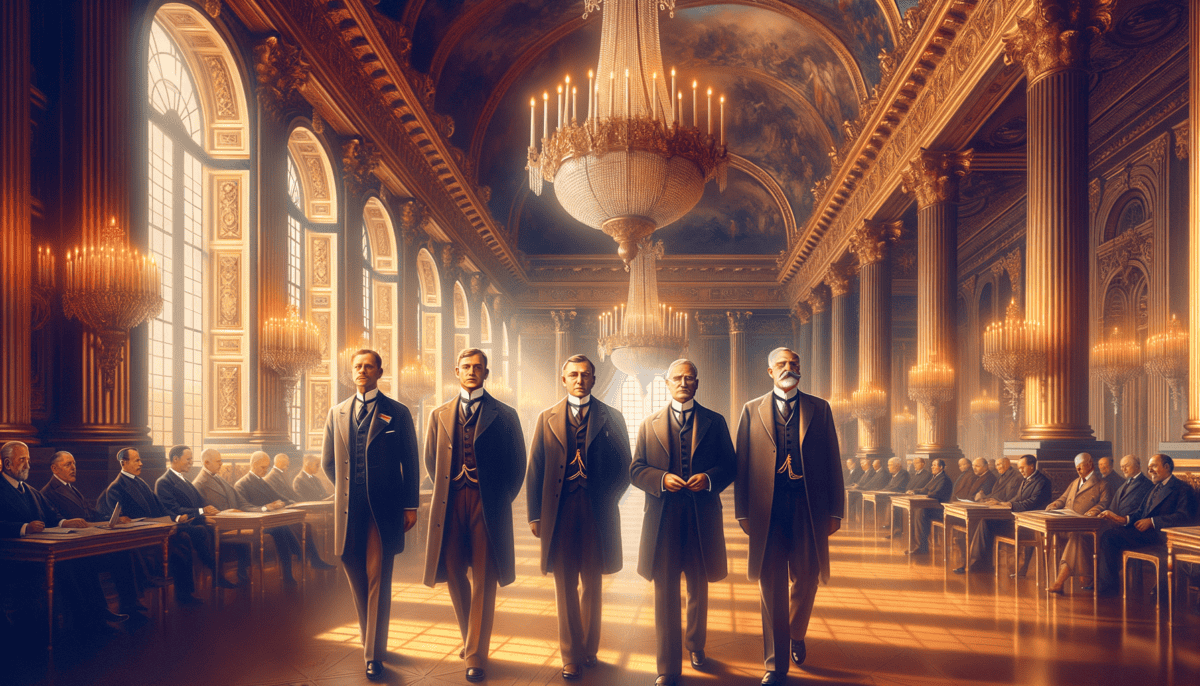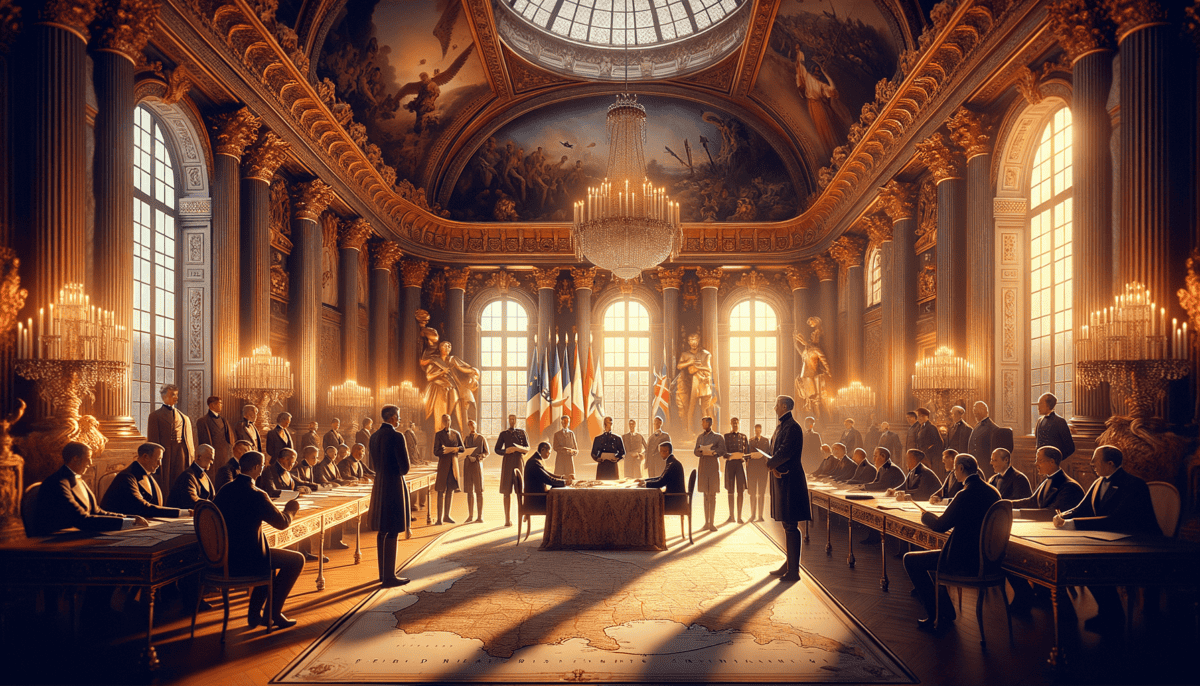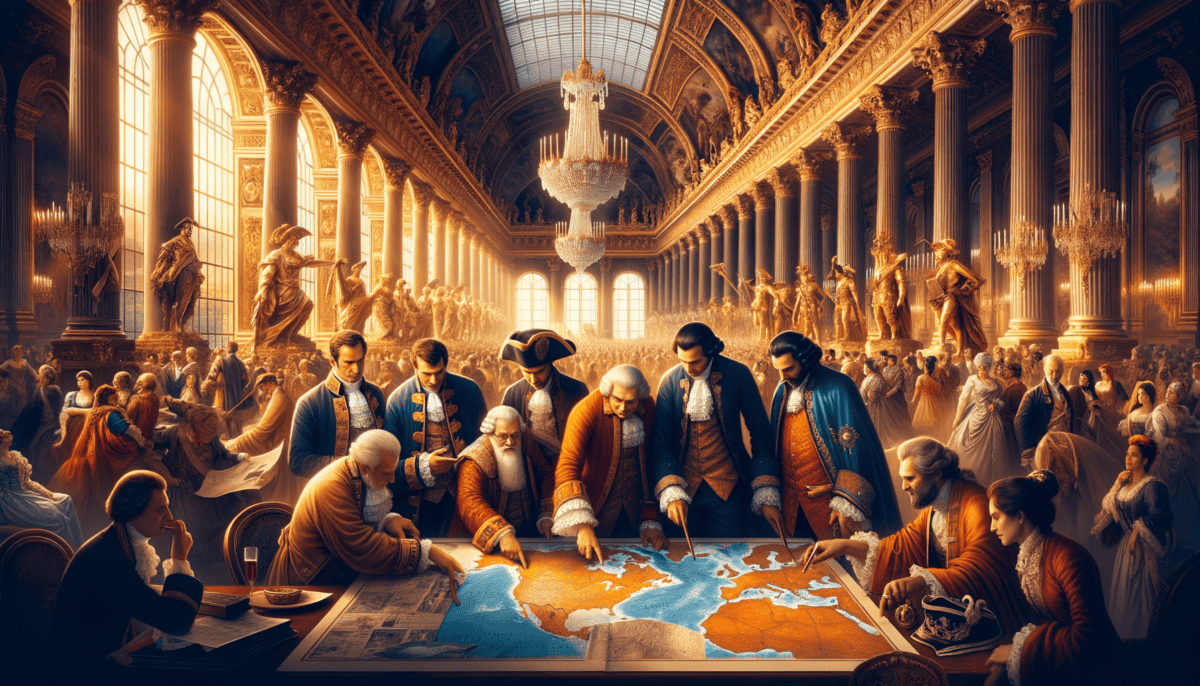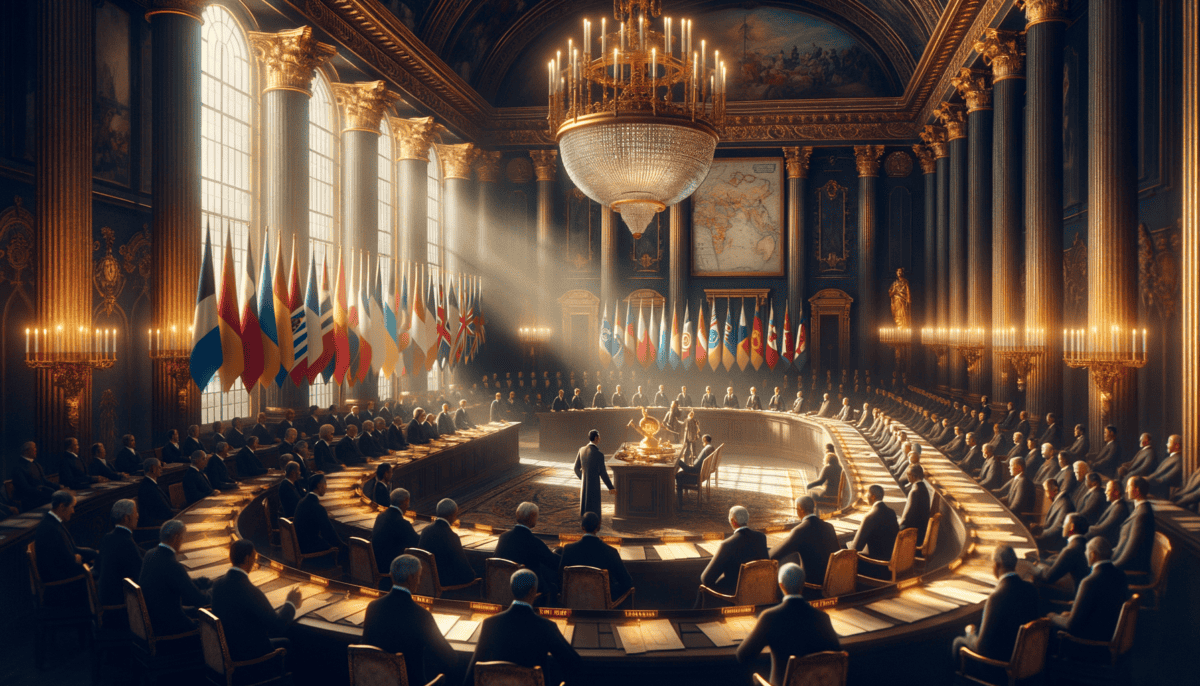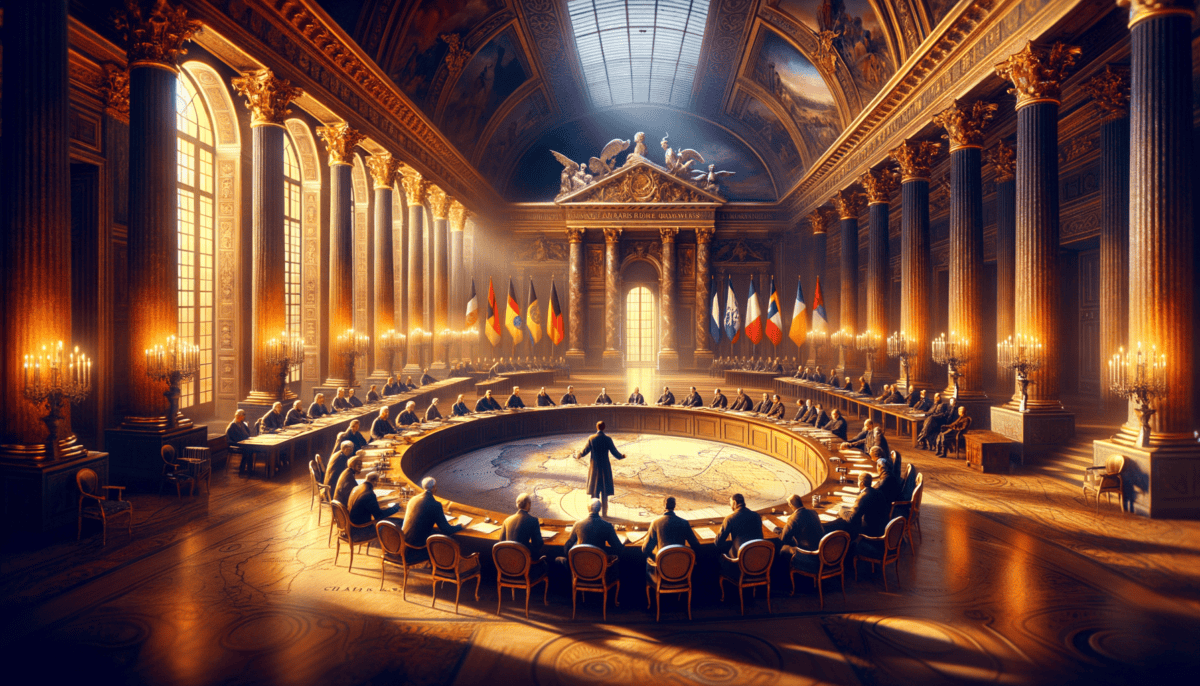The Drums of War’s End
The big clocks in Paris struck eleven on a cold November morning in 1918. The streets were quiet, then suddenly filled with joy! People ran from their homes, crying happy tears. The Great War was finally over!
For four long years, the world had been fighting. Now, the guns were silent. Soldiers could go home to their families. But the world they came back to was very different from the one they left.
A Tired World
Many cities lay in ruins. Buildings were broken, farms were empty, and people were hungry. It was like a giant had stomped through Europe, breaking everything in its path.
“We must rebuild,” said President Woodrow Wilson of America. “But first, we must make sure this never happens again.”
In towns and villages across Europe, families hung flags from their windows. Children who had never seen their fathers now hugged them tight. But not everyone got to celebrate. Many families had lost someone they loved in the war.
The People Who Would Make Peace
Important leaders from different countries agreed to meet in Paris. They would write new rules to keep the world safe. These were the main people who would meet:
- Woodrow Wilson from America
- Georges Clemenceau from France
- David Lloyd George from Britain
- Vittorio Orlando from Italy
Hope for Tomorrow
In the streets of Paris, workers began cleaning up. Farmers returned to their fields. Families started fixing their homes. Everyone hoped for a better future.
Little Marie looked up at the stars that night. “Mama,” she asked, “will there ever be another war?”
Her mother hugged her close. “The leaders are meeting to make sure there isn’t, my dear. They’re going to write something very important called the Treaty of Versailles.”
As winter approached, the world held its breath. The biggest peace meeting in history was about to begin. Leaders from many countries would gather in a beautiful palace near Paris called Versailles. They had a big job ahead – to fix a broken world and try to make sure such a terrible war would never happen again.
The Meeting of Giants
Snow fell softly on the Palace of Versailles as four important men walked up its grand steps. These were the Big Four, and they came to change the world!
Meet the Big Four
Georges Clemenceau from France wore his usual gray gloves and walked with a cane. Everyone called him “The Tiger” because he was so tough!
“France has suffered too much,” Clemenceau said. “We must make sure we are safe forever.”
Woodrow Wilson came all the way from America. He had big dreams of making the world peaceful. He wanted to create something new called the League of Nations, like a club where countries could talk instead of fight.
David Lloyd George from Britain stood tall in his neat suit. He wanted to be fair but also make sure Britain stayed strong. Vittorio Orlando from Italy completed the group, hoping his country would get something good from the talks.
Not Everyone Gets Along
Inside the beautiful palace, things weren’t always nice and friendly. The Big Four often disagreed:
- Clemenceau wanted to punish Germany
- Wilson wanted peace and friendship
- Lloyd George worried about being too harsh
- Orlando wanted more land for Italy
Working for Peace
Every day, they met in rooms with tall mirrors and golden walls. They talked and argued about how to make peace. Sometimes they got angry, but they kept trying.
Outside the palace, people waited for news. Would these four men find a way to make everyone happy? Could they really build a peaceful world?
Children played in the snowy streets of Paris, making up songs about the Big Four. They didn’t understand all the big words being used in the palace, but they knew something important was happening.
Hard Choices
As winter turned to spring, the Big Four worked harder. They had to make many difficult choices. Some countries would get bigger, others smaller. Some would have to pay money, others would receive help.
The world watched and waited. In the palace, maps were drawn and redrawn. Rules were written and rewritten. The Big Four knew their decisions would change the lives of millions of people.
As spring flowers bloomed in the palace gardens, they got closer to finishing their work. Soon, they would tell Germany what they had decided. Nobody knew how Germany would react to their plans.
The Price of Peace
The sun rose over Versailles, but it wasn’t a happy morning. Today, Germany would learn what the Big Four had decided.
Big Changes for Germany
Germany had to give up lots of land. It was like having a big backyard and suddenly being told you can’t play in most of it anymore. They lost special places like Alsace-Lorraine, which went back to France. ️
“It feels like they’re taking away pieces of our home,” whispered Maria, Hans’s mother, as she looked at the new map.
The German army had to become very small. They couldn’t have big ships or many soldiers anymore. It was like being told you can only have a tiny toy box when you used to have a room full of toys.
The Big Bill
The biggest shock was the money Germany had to pay. The Big Four said Germany must pay for all the damage from the war. It was more money than anyone could imagine!
- Had to pay billions of dollars
- Lost many factories
- Had to give away trains and ships
- Had to share food and materials
Sad Days in Germany
People in Germany felt very sad and angry. They thought the rules were too hard. Many couldn’t find jobs, and food was expensive. Children went to bed hungry.
A Growing Storm
In the streets of Berlin, people started to get angry. They felt like they were being punished too much. Some started listening to leaders who said they could make Germany strong again.
“One day,” they whispered, “we will be powerful again.”
The Big Four thought their rules would keep peace. But in Germany, people felt hurt and angry. Nobody knew it then, but these feelings would grow bigger and bigger, like a tiny seed that grows into a huge tree.
Looking Forward
Hans looked up at his mother one evening and asked, “Will things ever get better?”
She hugged him tight and said, “They must. But it will take time.”
Nobody knew it then, but the way Germany felt about these changes would lead to even bigger problems in the years to come. The story of Versailles wasn’t over – it was just beginning.
Drawing New Lines
The big map room in Versailles was buzzing with excitement. People stood around huge tables covered with colorful maps. They were about to change how the whole world looked! ️
Breaking Up Big Empires
The old empires were like giant puzzles being broken into smaller pieces. The Ottoman Empire and the Austro-Hungarian Empire were too big, the leaders said. It was time to make new countries! ✨
“Each group of people should have their own country,” Woodrow Wilson had said. He called this “self-determination.”
New countries appeared on the map like magic:
- Poland got its own country again
- Czechoslovakia became new
- Yugoslavia was created
- Many new countries in the Middle East
Happy New Countries
In Warsaw, Poland’s capital, people danced in the streets. After many years, they had their own country again!
Not Everyone Was Happy
But making new countries wasn’t easy. Sometimes different groups of people wanted the same land. It was like having one toy that two kids really wanted to play with.
“This used to be our land!” some people said. “No, it’s ours!” others answered.
Changes in the Middle East
Far away in the Middle East, new lines were being drawn too. The Ottoman Empire broke apart into many pieces. New places like Iraq, Syria, and Lebanon appeared on the map. ️
Growing Pains
The new countries were like baby birds learning to fly. Some did well right away. Others had a harder time. Many people found themselves living in new countries with new rules.
Little Maria in Prague woke up one morning and asked her mother, “Are we still in Austria?”
“No, dear,” her mother answered. “We’re in a new country called Czechoslovakia now.”
️ Make their own laws
Create their own money
Build their own police
Run their own schools
A New World Takes Shape
As the sun set over Versailles, the map makers put away their tools. The world looked very different now. Some borders we see today were first drawn in that big room in Versailles.
The Big Four hoped these changes would bring peace. But drawing new lines on maps was just the beginning. The real work of building new countries was just starting.
A New Hope for Peace
The sun streamed through the tall windows of Versailles as President Wilson stood before the gathered leaders. His eyes sparkled with hope as he shared his big dream – the League of Nations!
Wilson’s Big Dream
Wilson had traveled all the way from America with this wonderful idea. He imagined a place where countries could talk about their problems instead of fighting. ️
“No more big wars!” Wilson said. “Countries should be friends and help each other.”
Building Something New
The League of Nations would be like a big club for countries. But this wasn’t just any club – it was special! Here’s what the League would do:
- Help countries solve problems by talking
- Work together to make people healthier
- Share good ideas with each other
- Protect smaller countries from bullies
Making New Friends
Many countries liked Wilson’s idea. They quickly raised their hands to join! It was like the first day of school when everyone wants to make new friends.
Some Stayed Home
But not everyone joined the club. America, Wilson’s own country, said “No thank you.” This made Wilson very sad.
“But it was your idea!” people said to Wilson.
“Sometimes grown-ups are hard to understand,” Wilson sighed.
The League Gets to Work
The League set up its home in a beautiful building in Geneva, Switzerland. People from all over the world came to work there. ️
️ Helping sick people get better
Making mail delivery easier between countries
Helping people travel safely
Taking care of children who lost their homes in the war
Big Dreams, Big Challenges
The League was like a baby taking its first steps. Sometimes it did great things! Other times it stumbled and fell. But it was trying something that had never been done before – getting all the countries of the world to work together!
Wilson’s dream was big and beautiful. Even though the League wasn’t perfect, it showed people a new way to think about peace. It was like planting a tiny seed of hope that would grow into something bigger later.
A World Forever Changed
The summer breeze rustled through the gardens of Versailles. The big peace meeting was over, but its effects would last for many, many years.
Germany’s Hard Times
In Germany, people were very sad and angry about the treaty. They had to pay lots of money they didn’t have. It was like being asked to buy ice cream for the whole school when your piggy bank was empty!
“This isn’t fair!” many Germans said. Their country became very poor, and people were hungry.
New Countries, New Friends
But some people were happy! The treaty made new countries, like Poland and Czechoslovakia. It was like when new students join your class – everything feels fresh and exciting!
Learning Important Lessons
The grown-ups learned something very important from the Treaty of Versailles. Here’s what they discovered:
- Being too hard on others can make them angry
- Listen to everyone’s ideas, not just some people
- ❤️ Help others get better, don’t make them feel worse
- Peace works better when everyone feels happy
The Path to Another War
Sadly, the treaty didn’t keep peace forever. Germany’s anger grew bigger and bigger. A mean man named Hitler told Germans he would make their country strong again.
A Better Way Forward
After World War II, people remembered the mistakes of Versailles. They decided to try something different:
Help countries rebuild instead of punishing them
Work together to make everyone stronger
️ Build friendship bridges, not anger walls
Create the United Nations to keep peace better
The Story Lives On
Today, when world leaders meet, they think about what happened at Versailles. They try to be wiser and kinder. Like when you learn from a mistake to do better next time!
The Treaty of Versailles was like a big lesson for the whole world. Sometimes the best way to make friends isn’t by being tough, but by being kind and understanding. Today, countries still work on being good neighbors and solving problems by talking, not fighting. ️


